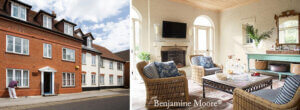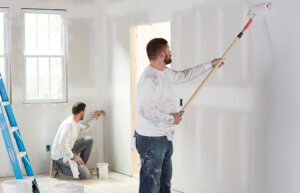Yes, or No? Things to consider beforehand.
While painting can transform almost any home interior or exterior, painting your brick may be a questionable endeavor.
Interior design speaking: Painting an interior wall or fireplace may be the “call of the day” and a great idea for a new updated look. Because the brick is indoors in a controlled environment, it can last a long time, but moving outside to paint your exterior brick may be a challenge.
Exterior design speaking: There is a lot of decision-making involved before proceeding with this life-changing project. Not just for you, but for your home as well.
Is it better to paint your exterior brick?
Consider this…The Good, The Bad, The Ugly and The Costly.
The Pros:
It’s Going to Look Great!
Throughout history brick has been used because of its architectural stability, durability and charm. So why do some homeowners find it very appealing?
1. Can boost curb appeal.
2. Makes dark and dreary rooms come to life.
3. Gives old fireplaces a facelift.
Check out this link: Benjamin Moore: Painting Fireplace
4. Painting brick can offer a smoother finish which is easier to clean and looks great. Because original bricks are porous, they can trap hard-to-clean dirt and debris and sometimes mold.
5. Painting your brick reduces the deterioration and extends the overall beauty and life of the brick.
6. Finally painting the brick becomes a sealant that can protect your house from harsh environments and weather conditions.
Tools You Will Need:
– Paint by 5-gal bucket with bucket rolling grid – Drop Cloth – All Purpose Primer
– 2 1/2” Angle-Sash nylon/polyester brush – Quality Interior or Exterior Paint
– All Purpose Primer/Sealer – Recommended Acrylic Latex Semi-Gloss paint – Painters Tape
– Paint Roller, ½” thick nap or thicker & extension pole – Scrub Brush – Sponge -Vacuum
– Wire Brush – Vinyl gloves – Ladder – Scaffolding if necessary – Paint can opener – Stir sticks
– Paint tray with liners for easy clean-up – Rags – Sandpaper -150-220
– All Purpose Citrus Cleaner, TSP or JOMAX cleaner
Check out these helpful links before you paint:
Benjamin Moore: How To Paint Brick Walls
Behr Paints: How To Paint Brick

Ready – Set – PAINT.
Fortunately, the painting process for bricks is not as complicated as its decision-making. The painting process takes time and effort but is straightforward, nonetheless.
Choose the correct Paint / Primer / Sealer for Brick
Acrylic-based masonry paint and primer are recommended most.
Brick has a naturally porous texture. So, choosing the right paint/primers is vital. If the wrong primer is used it may not adhere properly and peel. This would require extra coats to seal and re-cover the existing brick surface. Some paint/primer is not intended for bricks and will not stick properly and may waste your time.
So, for bricks, you have to go for acrylic-based masonry paint and primer. Masonry paints adhere easily and stick to the brick surfaces better to provide the desired finish.
Prepping Pressure Washing and cleaning the brick
Pressure Washing: Read the link below to get it right.
Pressure Washers Direct: How to Clean Brick and Mortar Walls
Be Careful! Too much pressure can damage brick and mortar, so be sure to adjust the pressure according to instructions from your dealer or on the pressure washer.
For exterior – Unpainted brick will be harder to clean, so pressure wash and brush thoroughly with soapy water or cleaning agent to remove dirt. If dirt is still intact, you can use cleaners like JOMAX or TSP to help you out. Important to read the TSP or JOMAX label for proper mixtures and water temperatures before using.
But remember to wear protective gear before applying.
Watch this video: Pressure Washers Direct: How to Clean Brick and Mortar Walls
Simple Steps:
1. First patch any holes in the wall with mortar compound and let dry at least a week before you wash. This will prevent pressured water from getting behind the walls to form mold.
2. Spray and wet the wall first with clean water – then add your cleaning agent and begin to pressure wash. Important to read the TSP or JOMAX label for proper mixtures and water temperatures before using.
Watch this video:
RUST-OLEUM: JOMAX Cleaner & Mildew Killer
Spray and soak the entire wall and let sit for 5-10 minutes. This gives the cleaning agent time to soak into the porous brick and dissolve any dirt, grime, and mold.
4. Spray thoroughly and scrub tough stains with a bit more elbow grease to remove.
5. Rinse the cleaning agent off the brick thoroughly and allow proper drying time.
Look over your job to see if there are any spots you missed – then clean again if necessary.
Once dried thoroughly, You are ready to begin your priming and painting process.
Priming and Painting.
For small repairs, it is best to use a Masonry Primer with block filler before you paint.
Apply the primer and let it dry according to dealer recommendations or instructions on the label.
Use an Acrylic Caulking after you prime, to fill cracks that block filler does not fill up completely.
Best Paint:
– Semi-Gloss paint is usually best for a good look and easy cleaning in the future.
– Whitewash Overcoat is another good choice for a more worn/antique look, which allows the old brick color to still show through.
Watch this video – Lowe’s: Whitewash your fireplace
Best Painting Applications: Prime and 2 coats of paint are recommended.
1. Using a sprayer. Spray the first coat and then it’s your choice to back roll with a roller to smooth out the paint or wait for the first coat to dry and spray the second coat.
Be sure to read the instructions and drying times between coats on the paint label.
Start spray painting with a bit more pressure to ensure that the paint is applied well to the texture. You can apply a second layer of paint if you think the first one is not enough.
Watch this video – Bunnings Warehouse: How To Paint Brick
If you are unsure, always discuss the operation and technique of spray equipment with the dealer for the best results.
This is like learning to dance for the first time. A lesson in body motion and dexterity – adjusting your arm and body movement to ensure a good rhythm to apply the paint.
2. Roller and Back Brush: Use at least 1/2” nap roller – After rolling on your paint, brush back over the paint to smooth out any heavy paint build-up and even the finish.
Watch These Videos:
Benjamine Moore: Painting Brick
Lowes: Painting Brick Exterior

Be sure to invest in a quality brush and roller capable of painting on rough surfaces.
The Cons: The Bad, The Ugly and The Costly.
Brick and block are porous – Painting, if not sealed completely can trap moisture in the brick – resulting in deterioration and peeling paint in years to come.
Climate can cause serious exterior damage: Depending upon your regional weather: Repeated freezing, then thaw, or constant fluctuations in damp and humid weather can cause serious degradation of the brick. Because of these adverse conditions, paint can separate from the brick and peel, leaving damaged brick beneath it.
Un-Painting Brick: “Ooops”, the paint is peeling and coming off, or you decide you don’t like the paint after a few years. Now you have the painstaking task of stripping the paint, sand blasting, power washing and potentially damaging the brick further getting it back to near normal.
We’ll leave this decision up to you.
But should you decide to paint outside, here are some useful project tips.
Final Considerations: Look before you leap:
Don’t paint damaged brick. Fix it first.
In some cases, paint can help cover deterioration and other similar issues. But this is not the case for bricks. A fresh coat will not hide imperfections like mold or cracks. Painting over them may even cause more problems. So, before painting, you have to examine the surface and repair holes, cracks or replace the damaged bricks.
Painting brick is permanent.
No going back without painstaking and costly measures.
Once you run your brush on your brick walls, there will be no turning back. Painted brick has to stay painted and repainted at least every seven years to prevent damage from moisture. But, since brick is open to repaints, you can change to whatever color you like. Just remember that painted brick means a lifelong commitment.
No. No. No. Never paint brand new brick.
A new brick still has that powdery texture, which will be a problem with the paint’s adherence. Wait for a month or two before painting on the new brick. Otherwise, you’ll probably end up with paint that peels off and waste your time.
Now then. DIY?, Or consider calling El Gato
Painting on brick is not a job that you should take lightly. It takes time and a lot of things to consider before starting. If you’ve settled on painting over the bricks but don’t have a skill for DIY, hire the professionals to do the job for you!
El Gato Painting is the perfect service provider for your painted brick dilemma. They utilize the right techniques, using the proper tools for a seamless paint job over your brick exterior.
El Gato Painting has been in the industry for four decades and has partnered with different homeowners for painting and restoration services.
Painting Concrete Block?
Block is primarily used for foundations and commercial construction.
Painting on a block is a similar process. If you are painting a foundation or retaining wall, you may run into moisture intrusion and dampness of the block. This would require further preparation and research on another blog topic.
Acquire this information from your authorized dealer or paint manufacturer.
Conclusion
El Gato Painting has the knowledge, track record, and reputation to do your project right. The first time.
Topics we will discuss with you before you hire us.
- We’ll furnish you with our complete list of satisfied customers.
- Verify we are licensed and insured.
- Agree with you in writing on price and responsibilities.
- Be sure you get our best warranty for the work.
- Make sure we use high-quality materials and paints.
- We’ll carefully go over our 21 steps of preparation and application.
- Welcome your questions and concerns.
- Look forward to your final inspection of our crew’s excellent work.
Please visit our Certification pages:
– Google Page for our long list of 5 Star Ratings.
– El Gato Painting Services From our website here
– Reviews for the company Customer testimonials from our website here
This will give you the peace of mind that you have hired trustworthy and reliable professionals.
Contact El Gato Painting Services today and get a free quotation!
Click on Cat to PRINT
The El Gato Difference brochure















Comments are closed.